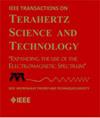Terahertz Characterization of Cable Terminal: A Debye-PSO Modeling and Inversion Approach
IF 3.9
2区 工程技术
Q2 ENGINEERING, ELECTRICAL & ELECTRONIC
IEEE Transactions on Terahertz Science and Technology
Pub Date : 2025-03-12
DOI:10.1109/TTHZ.2025.3569133
引用次数: 0
Abstract
Terahertz (THz) wave propagation in insulation materials of cable terminal is governed by their optical and dielectric properties. This study investigated these properties in cross-linked polyethylene (XLPE) and ethylene propylene rubber (EPR) cable terminal materials using THz time-domain spectroscopy (THz-TDS) in the 0.2–1.5 THz range. We measured and analyzed four key parameters: refractive index n1(ω), absorption coefficient α1(ω), and the real and imaginary parts of the dielectric constant [ϵ1′(电缆终端的太赫兹特性:一种Debye-PSO建模和反演方法
太赫兹波在电缆终端绝缘材料中的传播受其光学特性和介电特性的制约。本研究利用太赫兹时域谱(THz- tds)在0.2 ~ 1.5太赫兹范围内研究了交联聚乙烯(XLPE)和乙丙橡胶(EPR)电缆终端材料的这些性能。对XLPE、EPR、应力管和伞裙等6种绝缘材料的折射率n1(ω)、吸收系数α1(ω)和介电常数的实部和虚部[ϵ1’(ω)和ϵ1’(ω)]进行了测量和分析。采用Debye模型对偶极子弛豫过程进行理论分析,并采用粒子群优化(PSO)方法克服了传统非线性拟合方法在色散模型中的局限性。我们的综合方法结合了实验测量,理论建模和优化技术来建立这些材料的基本太赫兹波段参数。结果表明,材料的微观结构与其电磁性能之间存在明显的相关性。本文为基于太赫兹的电缆终端内部缺陷检测提供了必要的理论基础和参考数据。此外,电磁特性变化的微观结构分析为使用太赫兹技术评估电缆终端老化状态提供了新的见解。
本文章由计算机程序翻译,如有差异,请以英文原文为准。
求助全文
约1分钟内获得全文
求助全文
来源期刊

IEEE Transactions on Terahertz Science and Technology
ENGINEERING, ELECTRICAL & ELECTRONIC-OPTICS
CiteScore
7.10
自引率
9.40%
发文量
102
期刊介绍:
IEEE Transactions on Terahertz Science and Technology focuses on original research on Terahertz theory, techniques, and applications as they relate to components, devices, circuits, and systems involving the generation, transmission, and detection of Terahertz waves.
 求助内容:
求助内容: 应助结果提醒方式:
应助结果提醒方式:


